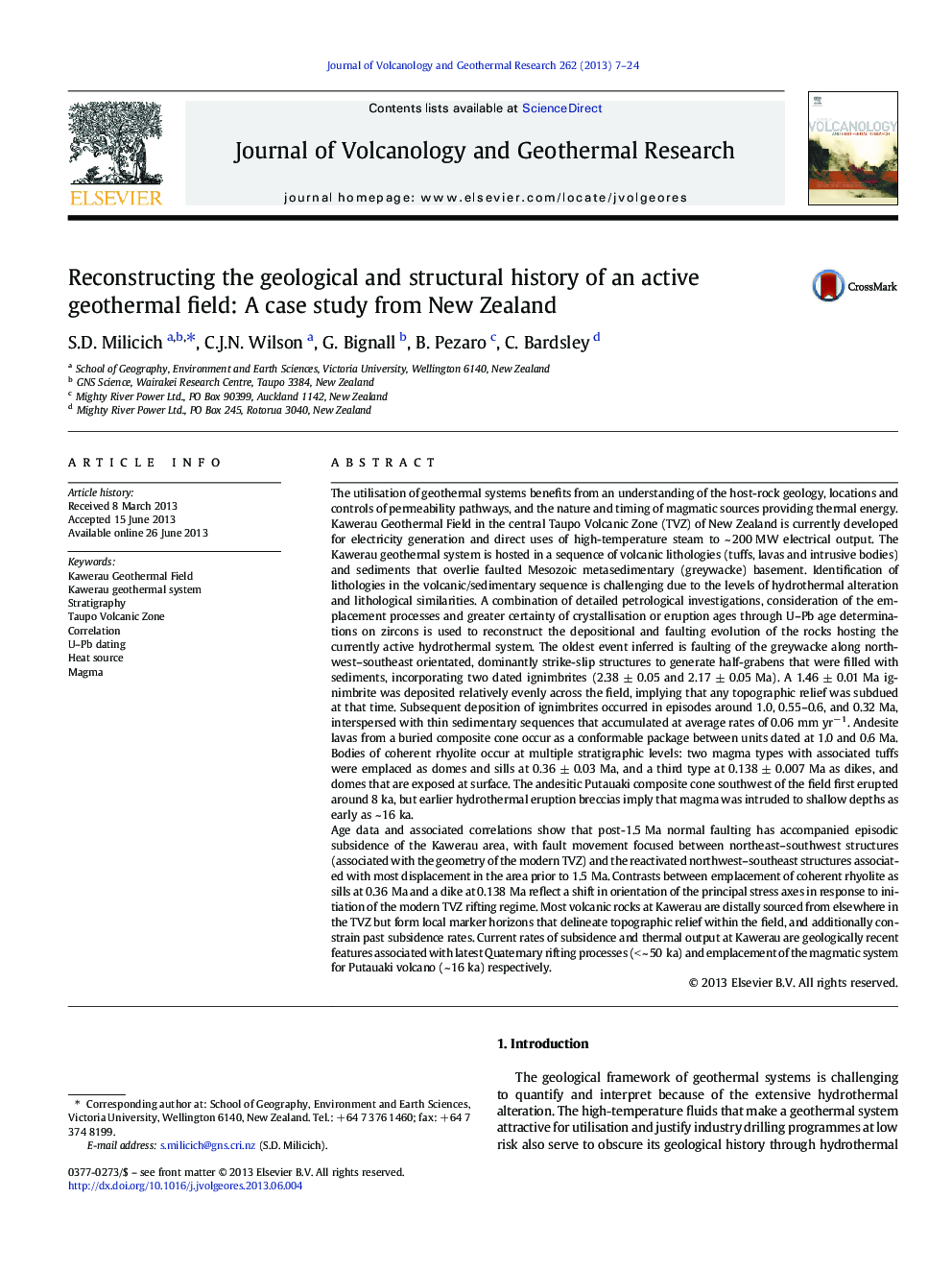| کد مقاله | کد نشریه | سال انتشار | مقاله انگلیسی | نسخه تمام متن |
|---|---|---|---|---|
| 4713082 | 1638359 | 2013 | 18 صفحه PDF | دانلود رایگان |
• Rates of accumulation of deposits and subsidence across the field have been non-uniform.
• Ignimbrite previously correlated as Rangitaiki ignimbrite has been shown to be much older.
• Sediment intervals previously allocated to Huka Falls Formation have been shown to be much older.
• Change from sills to dikes at ~ 0.138 Ma reflects an initiation of the modern TVZ rifting regime.
• The modern geothermal system is superimposed on an area with previous magmatic activity.
The utilisation of geothermal systems benefits from an understanding of the host-rock geology, locations and controls of permeability pathways, and the nature and timing of magmatic sources providing thermal energy. Kawerau Geothermal Field in the central Taupo Volcanic Zone (TVZ) of New Zealand is currently developed for electricity generation and direct uses of high-temperature steam to ~ 200 MW electrical output. The Kawerau geothermal system is hosted in a sequence of volcanic lithologies (tuffs, lavas and intrusive bodies) and sediments that overlie faulted Mesozoic metasedimentary (greywacke) basement. Identification of lithologies in the volcanic/sedimentary sequence is challenging due to the levels of hydrothermal alteration and lithological similarities. A combination of detailed petrological investigations, consideration of the emplacement processes and greater certainty of crystallisation or eruption ages through U–Pb age determinations on zircons is used to reconstruct the depositional and faulting evolution of the rocks hosting the currently active hydrothermal system. The oldest event inferred is faulting of the greywacke along northwest–southeast orientated, dominantly strike-slip structures to generate half-grabens that were filled with sediments, incorporating two dated ignimbrites (2.38 ± 0.05 and 2.17 ± 0.05 Ma). A 1.46 ± 0.01 Ma ignimbrite was deposited relatively evenly across the field, implying that any topographic relief was subdued at that time. Subsequent deposition of ignimbrites occurred in episodes around 1.0, 0.55–0.6, and 0.32 Ma, interspersed with thin sedimentary sequences that accumulated at average rates of 0.06 mm yr− 1. Andesite lavas from a buried composite cone occur as a conformable package between units dated at 1.0 and 0.6 Ma. Bodies of coherent rhyolite occur at multiple stratigraphic levels: two magma types with associated tuffs were emplaced as domes and sills at 0.36 ± 0.03 Ma, and a third type at 0.138 ± 0.007 Ma as dikes, and domes that are exposed at surface. The andesitic Putauaki composite cone southwest of the field first erupted around 8 ka, but earlier hydrothermal eruption breccias imply that magma was intruded to shallow depths as early as ~ 16 ka.Age data and associated correlations show that post-1.5 Ma normal faulting has accompanied episodic subsidence of the Kawerau area, with fault movement focused between northeast–southwest structures (associated with the geometry of the modern TVZ) and the reactivated northwest–southeast structures associated with most displacement in the area prior to 1.5 Ma. Contrasts between emplacement of coherent rhyolite as sills at 0.36 Ma and a dike at 0.138 Ma reflect a shift in orientation of the principal stress axes in response to initiation of the modern TVZ rifting regime. Most volcanic rocks at Kawerau are distally sourced from elsewhere in the TVZ but form local marker horizons that delineate topographic relief within the field, and additionally constrain past subsidence rates. Current rates of subsidence and thermal output at Kawerau are geologically recent features associated with latest Quaternary rifting processes (< ~ 50 ka) and emplacement of the magmatic system for Putauaki volcano (~ 16 ka) respectively.
Journal: Journal of Volcanology and Geothermal Research - Volume 262, 15 July 2013, Pages 7–24
